Hot air balloon


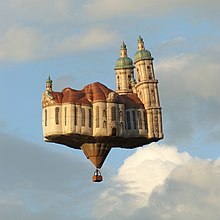
Ahot air balloonis alighter-than-airaircraft consisting of a bag, called an envelope, which contains heated air. Suspended beneath is agondolaorwicker basket(in some long-distance or high-altitude balloons, a capsule), which carries passengers and a source of heat, in most cases an open flame caused by burning liquidpropane.The heated air inside the envelope makes itbuoyant,since it has alower densitythan the colder air outside the envelope. As with allaircraft,hot air balloons cannot fly beyond theatmosphere.The envelope does not have to be sealed at the bottom, since the air inside the envelope is at about the same pressure as the surrounding air. In modern sport balloons the envelope is generally made fromnylonfabric, and the inlet of the balloon (closest to the burner flame) is made from a fire-resistant material such asNomex.Modern balloons have been made in many shapes, such as rocket ships and the shapes of various commercial products, though the traditional shape is used for most non-commercial and many commercial applications.
The hot air balloon is the first successful human-carryingflighttechnology. The first untethered manned hot air balloon flight in the world was performed inParis,France, byJean-François Pilâtre de RozierandFrançois Laurent d'Arlandeson November 21, 1783,[1]in a balloon created by theMontgolfier brothers.[2]The first hot air balloon flown in the Americas was launched from theWalnut Street Jailin Philadelphia on January 9, 1793, by the French aeronautJean-Pierre Blanchard.[3]Hot air balloons that can be propelled through the air rather than simply drifting with thewindare known asthermal airships.
History
Premodern and unmanned balloons
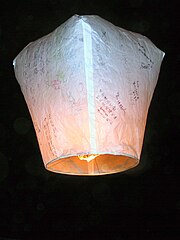
A precursor of the hot air balloon was thesky lantern(simplified Chinese:Khổng minh đăng;traditional Chinese:Khổng minh đăng).Zhuge Liangof theShu Hankingdom, during theThree Kingdomsera (220–280 CE), used these airborne lanterns for military signaling.[4]The Mongolian army studiedKongming lanternsfrom China and used them in theBattle of Legnicaduring the Mongol invasion of Poland in the 13th century.[5]This is the first time ballooning was known in the western world.
In the 18th century the colonial Brazilian Jesuit priestBartolomeu de Gusmãoenvisioned an aerial apparatus namedPassarola,which was the predecessor of the hot air balloon. ThePassarolawas intended to serve as air vessel in order to facilitate communication and as a strategical device.[6]In 1709John V of Portugaldecided to fund Bartolomeu de Gusmão's project following a petition made by the Jesuit priest,[7]and an unmanned demonstration was performed atCasa da Índiain the presence of John V and the queen,Maria Anna of Austria,with the Italian cardinalMichelangelo Conti,two members of the Portuguese Royal Academy of History, one Portuguese diplomat and one chronicler serving as witnesses. This event would bring some European attention to this event and this project. A later article dated on October 20, 1786, by the LondonDaily Universal Registerwould state that the inventor was able to raise himself by the use of his prototype. Also in 1709, the Portuguese Jesuit wroteManifesto summário para os que ignoram poderse navegar pelo elemento do ar(Short Manifesto for those who are unaware that is possible to sail through the element air); he also left designs for a manned air vessel.
In the 1970s, balloonistJulian Notthypothesized that theNazca Linesgeoglyphs' creation two millennia ago could have been guided byNazca leadersin a balloon, possibly the earliest hot air balloon flights in human history.[8]To support this theory, in 1975 he designed and piloted the Nazca Prehistoric Balloon, claiming to have used only methods and materials available to the Pre-Inca Peruvians 1,000 years ago.[9][10]
First manned flight

The French brothers Joseph-Michel and Jacques-ÉtienneMontgolfierdeveloped a hot-air balloon inAnnonay,Ardèche,France, and demonstrated it publicly on September 19, 1783, making an unmanned flight lasting 10 minutes. After experimenting with unmanned balloons and flights with animals, the first balloon flight with humans aboard, a tethered flight, performed on or around October 15, 1783, by Jean-Francois Pilatre de Rozier, who made at least one tethered flight from the yard of the Reveillon workshop in theFaubourg Saint-Antoine.Later that same day, Pilatre de Rozier became the second human to ascend into the air, reaching an altitude of 26 m (85 ft), the length of the tether.[11][12]The first free flight with human passengers was made a few weeks later, on November 21, 1783.[2]King Louis XVIhad originally decreed that condemned criminals would be the firstpilots,but de Rozier, along withMarquis François d'Arlandes,petitioned successfully for the honor.[13][14][15] Thefirst military useof a hot air balloon happened in 1794 during thebattle of Fleurus,when the French used the balloonl'Entreprenantfor observation.[16]
Jean-Pierre Blanchardbecame the first person to fly a hot air balloon in various countries, including the United States, the Netherlands, and Germany. His most notable flight crossed theEnglish Channelheading to theDover Castleaccompanied byJohn Jeffries,which occurred on 7 January 1785. In 1808, Blanchard suffered a heart attack while ballooning above The Hague, fell from his balloon, and experienced fatal injuries. His wifeSophie Blanchardcontinued his profession, but also died a decade later on a balloon, due to a firework festival causing the hydrogen in the balloon to be set on fire.[17]
Modern balloons


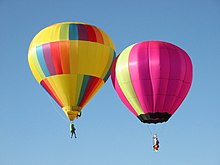
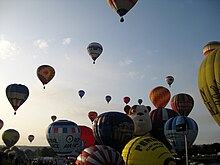
Modern hot air balloons, with an onboard heat source, were developed byEd Yostand Jim Winker, beginning during the 1950s; their work resulted in his a first successful flight on October 22, 1960.[18]The first modern hot air balloon to be made in the United Kingdom (UK) was theBristol Belle,built in 1967. Presently, hot air balloons are used primarily for recreation.
Records
Hot air balloons are able to fly to extremely high altitudes. On November 26, 2005Vijaypat Singhaniaset the world altitude record for highest hot air balloon flight, reaching 21,027 m (68,986 ft). He took off from downtownMumbai,India, and landed 240 km (150 mi) south in Panchale.[19]The previous record of 19,811 m (64,997 ft) had been set byPer Lindstrandon June 6, 1988, inPlano, Texas.
On January 15, 1991, theVirgin Pacific Flyerballoon completed the longest flight in a hot air balloon, whenPer Lindstrand(born in Sweden, but resident in the UK) andRichard Bransonof the UK flew 7,671.91 km (4,767.10 mi) from Japan to Northern Canada. With a volume of 74,000 cubic meters (2.6 million cubic feet), the balloon envelope was the largest ever built for a hot air craft. Designed to fly in the trans-oceanicjet streams,thePacific Flyerrecorded the fastest ground speed for a manned balloon at 394 km/h (245 mph). The longest duration record was set by Swiss psychiatristBertrand Piccard(Auguste Piccard's grandson) and Briton Brian Jones, flying in the Breitling Orbiter 3. It was the first nonstop trip around the world by balloon. The balloon left Château-d'Oex, Switzerland, on March 1, 1999, and landed at 1:02 a.m. on March 21 in the Egyptian desert 500 km (300 mi) south of Cairo. The two men exceeded distance, endurance, and time records, traveling 19 days, 21 hours, and 55 minutes.Steve Fossett,flying solo, exceeded the record for briefest time traveling around the world on 3 July 2002 on his sixth attempt,[20]in 320 h 33 min.[21]Fedor Konyukhovflew solo round the world on his first attempt in a hybrid hot air/helium balloon from 11 to 23 July 2016[22]for a round-the world time of 268 h 20 min.[21]
Construction
A hot air balloon for manned flight uses a single-layered, fabric gas bag (lifting "envelope" ), with an opening at the bottom called the mouth or throat. Attached to the envelope is a basket, or gondola, for carrying the passengers. Mounted above the basket and centered in the mouth is the "burner", which injects a flame into the envelope, heating the air within. The heater or burner is fueled bypropane,aliquefied gasstored in pressure vessels, similar to high-pressureforkliftcylinders.[23][24]
Envelope
Modern hot air balloons are usually made of materials such asripstop nylonordacron(apolyester).[25]
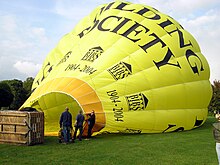
During the manufacturing process, the material is cut into panels and sewn together, along with structuralload tapesthat carry the weight of the gondola or basket. The individual sections, which extend from the throat to the crown (top) of the envelope, are known asgoresor gore sections. Envelopes can have as few as 4 gores or as many as 24 or more.[26]
Envelopes often have a crown ring at their very top. This is a hoop of smooth metal, usually aluminium, and approximately 30 cm (1 ft) in diameter. Vertical load tapes from the envelope are attached to the crown ring.
At the bottom of the envelope the vertical load tapes are sewn into loops that are connected to cables (one cable per load tape). These cables, often referred to asflying wires,are connected to the basket bycarabiners.
Seams
The most common technique for sewing panels together is called theFrenchfelled,French fell,ordouble lapseam.[27][28][29][30]The two pieces of fabric are folded over on each other at their common edge, possibly with a load tape as well, and sewn together with two rows of parallel stitching. Other methods include aflat lapseam, in which the two pieces of fabric are held together simply with two rows of parallel stitching, and azigzag,where parallel zigzag stitching holds a double lap of fabric.[29]
Coatings
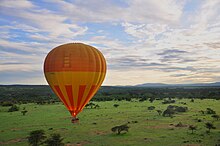
The fabric (or at least part of it, the top 1/3, for example) may be coated with a sealer, such assiliconeorpolyurethane,to make it impermeable to air.[31]It is often the degradation of this coating and the corresponding loss of impermeability that ends the effective life of an envelope, not weakening of the fabric itself. Heat, moisture, and mechanical wear-and-tear during set-up and pack-up are the primary causes of degradation. Once an envelope becomes tooporousto fly, it may be retired and discarded or perhaps used as a "rag bag": cold-inflated and opened for children to run through. Products for recoating the fabric are becoming available commercially.[32]
Sizes and capacity
A range of envelope sizes is available. The smallest, one-person, basket-less balloons (called "Hoppers"or" Cloudhoppers ") have as little as 600 m3(21,000 cu ft) of envelope volume;[33]for a perfect sphere the radius would be around 5 m (16 ft). At the other end of the scale, balloons used by commercial sightseeing operations may be able to carry well over two dozen people, with envelope volumes of up to 17,000 m3(600,000 cu ft).[33]The most-used size is about 2,800 m3(99,000 cu ft), allowing to carry 3 to 5 people.
Vents

The top of the balloon usually has a vent of some sort, enabling the pilot to release hot air to slow an ascent, start a descent, or increase the rate of descent, usually for landing. Some hot air balloons haveturning vents,which are side vents that, when opened, cause the balloon to rotate. Such vents are particularly useful for balloons with rectangular baskets, to facilitate aligning the wider side of the basket for landing.[34]
The most common type of top vent is a disk-shaped flap of fabric called aparachute vent,invented by Tracy Barnes.[35]The fabric is connected around its edge to a set of "vent lines" that converge in the center. (The arrangement of fabric and lines roughly resembles aparachute—thus the name.) These "vent lines" are themselves connected to a control line that runs to the basket. A parachute vent is opened by pulling on the control line. Once the control line is released, the pressure of the remaining hot air pushes the vent fabric back into place. A parachute vent can be opened briefly while in flight to initiate a rapid descent. (Slower descents are initiated by allowing the air in the balloon to cool naturally.) The vent is pulled open completely to collapse the balloon after landing.
An older, and presently less commonly used, style of top vent is called a "Velcro-style "vent. This too is a disk of fabric at the top of the balloon. However, rather than having a set of" vent lines "that can repeatedly open and close the vent, the vent is secured by" hook and loop "fasteners (such as Velcro) and is only opened at the end of the flight. Balloons equipped with a Velcro-style vent typically have a second" maneuvering vent "built into the side (as opposed to the top) of the balloon. Another common type of top design is the" smart vent ", which, rather than lowering a fabric disc into the envelope as in the" parachute "type, gathers the fabric together in the center of the opening. This system can theoretically be used for in-flight maneuvering, but is more commonly used only as a rapid-deflation device for use after landing, of particular value in high winds. Other designs, such as the" pop top "and" MultiVent "systems, have also attempted to address the need for rapid deflation on landing, but the parachute top remains popular as an all-around maneuvering and deflation system.
Shape
Besides special shapes, possibly for marketing purposes, there are several variations on the traditional "inverted tear drop" shape. The simplest, often used by home builders, is ahemisphereon top of a truncatedcone.More sophisticated designs attempt to minimize the circumferentialstresson the fabric, with different degrees of success depending on whether they take fabric weight and varying air density into account. This shape may be referred to as "natural".[36]Finally, some specialized balloons are designed to minimizeaerodynamic drag(in the vertical direction) to improve flight performance in competitions.[37]
Basket

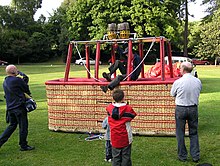
Hot air balloon baskets are commonly made ofwovenwickerorrattan.These materials have proven to be sufficiently light, strong, and durable for balloon flight. Such baskets are usually rectangular or triangular in shape. They vary in size from just big enough for two people to large enough to carry thirty.[38]Larger baskets often have internal partitions for structural bracing and to compartmentalize the passengers. Small holes may be woven into the side of the basket to act as foot holds for passengers climbing in or out.[39]
Baskets may also be made ofaluminium,especially a collapsible aluminium frame with a fabric skin, to reduce weight or increase portability.[40]These may be used by pilots without a ground crew or who are attempting to set altitude, duration, or distance records. Other specialty baskets include the fully enclosed gondolas used for around-the-world attempts[41]and baskets that consist of little more than a seat for the pilot and perhaps one passenger.
Burner


The burner unit gasifies liquidpropane,[42]mixes it with air, ignites the mixture, and directs the flame and exhaust into the mouth of the envelope. Burners vary in power output; each will generally produce 2 to 3 MW of heat (7 to 10 millionBTUsper hour), with double, triple, or quadruple burner configurations installed where more power is needed.[43][44]The pilot actuates a burner by opening a propane valve, known as ablast valve.The valve may be spring-loaded, so that it closes automatically, or it may stay open until closed by the pilot. The burner has apilot lightto ignite the propane and air mixture. The pilot light may be lit by the pilot with an external device, such as aflintstriker or alighter,or with a built-inpiezoelectricspark.[45]
Where more than one burner is present, the pilot can use one or more at a time, depending on the desired heat output. Each burner has a metal coil of propane tubing the flame shoots through to preheat the incoming liquid propane. The burner unit may be suspended from the mouth of the envelope or supported rigidly over the basket. The burner unit may be mounted on agimbalto enable the pilot to aim the flame and avoid overheating the envelope fabric. A burner may have a secondary propane valve that releases propane more slowly and thereby generates a different sound. This is called awhisper burnerand is used for flight over livestock to lessen the chance of spooking them. It also generates a more yellow flame and is used for night glows because it lights up the inside of the envelope better than the primary valve.
Fuel tanks
Propane fuel tanks are usually cylindricalpressure vesselsmade fromaluminium,stainless steel,ortitaniumwith a valve at one end to feed the burner and to refuel. They may have afuel gaugeand apressure gauge.Common tank sizes are 38, 57 and 76 litres (10, 15 and 20 US gallons).[31]They may be intended for upright or horizontal use and may be mounted inside or outside the basket.

The pressure necessary to force the fuel through the line to the burner may be supplied by thevapor pressureof the propane itself, if warm enough, or by the introduction of an inert gas such asnitrogen.[45]Tanks may be preheated with electricalheat tapesto produce sufficient vapor pressure for cold-weather flying.[46]Warmed tanks are usually also wrapped in an insulating blanket to preserve heat during the setup and flight.
Instrumentation
A balloon may be outfitted with a variety of instruments to aid the pilot. These commonly include analtimeter,a rate-of-climb (vertical-speed) indicator known as avariometer,envelope (air) temperature, and ambient (air) temperature.[47]AGPSreceiver can be useful to indicate ground speed (traditional aircraft air-speed indicators would be useless) and direction.
Combined mass
The combined mass of an average system can be calculated as follows:[31]
Component Pounds Kilograms Mass fraction 2,800 m3(100,000 cu ft) envelope 250 113.4 5-passenger basket 140 63.5 Double burner 50 22.7 3 76 L (20 US gal) fuel tanks full of propane 3 × 135 = 405 183.7 5 passengers 5 × 150 = 750 340.2 Subtotal 1595 723.5 2,800 m3(100,000 cu ft) of heated air* 5922 2686.2 Total (3.76 tons) 7517 3409.7
- * Using adensityof 0.9486 kg/m3(0.05922 lb/cu ft) for dry air heated to 99 °C (210 °F).
Theory of operation
Generating lift
Increasing the air temperature inside the envelope makes it less dense than the surrounding (ambient) air. The balloon floats because of the buoyant force exerted on it. This force is the same force that acts on objects when they are in water and is described byArchimedes' principle.The amount of lift (orbuoyancy) provided by a hot air balloon depends primarily upon the difference between the temperature of the air inside the envelope and the temperature of the air outside the envelope. For most envelopes made of nylon fabric, the maximal internal temperature is limited to approximately 120 °C (250 °F).[48]
The melting point of nylon is significantly greater than this maximaloperating temperature—about 230 °C (450 °F)—but higher temperatures cause the strength of the nylon fabric to degrade more quickly over time. With a maximal operating temperature of 120 °C (250 °F), balloon envelopes can generally be flown for between 400 and 500 hours before the fabric needs to be replaced. Many balloon pilots operate their envelopes at temperatures significantly less than the maximum to extend envelope-fabric life.
The lift generated by 2,800 m3(100,000 cu ft) of dry air heated to various temperatures may be calculated as follows:
Air temperature Air density Air mass Lift generated 20 °C (68 °F) 1.2041 kg/m3(0.07517 lb/cu ft) 3,409.7 kg (7,517 lb) 0 lb, 0 kg 99 °C (210 °F) 0.9486 kg/m3(0.05922 lb/cu ft) 2,686.2 kg (5,922 lb) 723.5 kg (1,595 lb) 120 °C (248 °F) 0.8978 kg/m3(0.05605 lb/cu ft) 2,542.4 kg (5,605 lb) 867.3 kg (1,912 lb)
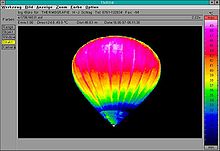
Thedensity of airat 20 °C (68 °F) is about 1.2 kg/m3(0.075 lb/cu ft). The total lift for a balloon of 2,800 m3(100,000 cu ft) heated to 99 °C (210 °F) would be 723.5 kg (1,595 lb). This is just enough to generate neutral buoyancy for the total system mass (not including the heated air trapped in the envelope, of course) stated in the previous section. Liftoff would require a slightly greater temperature, depending on the desired rate of climb. In reality, the air contained in the envelope is not all at the same temperature, as the accompanying thermal image shows, and so these calculations are based on averages.
For typical atmospheric conditions (20 °C or 68 °F), a hot air balloon heated to 99 °C (210 °F) requires about 3.91 m3of envelope volume to lift 1 kilogram (equivalently, 62.5 cu ft/lb). The precise amount of lift provided depends not only upon the internal temperature mentioned above, but the external temperature, altitude above sea level, and humidity of the air surrounding. On a warm day, a balloon cannot lift as much as on a cool day, because the temperature required for launch will exceed the maximum sustainable for nylon envelope fabric. Also, in the lower atmosphere, the lift provided by a hot air balloon decreases about 3% per 1,000 m (1% per 1,000 ft) of altitude gained.[49]
Types of Hot Air Balloons
There are several different types of hot air balloons, all with different means of taking and sustaining flight.
Montgolfier

Standard hot air balloons are known asMontgolfier balloonsand rely solely on the buoyancy of hot air provided by the burner and contained by the envelope.[50]This style of balloon was developed by theMontgolfier brothersand had its first public demonstration on 4 June 1783 with an unmanned flight lasting 10 minutes, followed later that year with manned flights.[51]
Gas

Instead of using regular air it is also possible to use lighter than air gasses such as Helium or Hydrogen to lift the balloon,[53]though this means it is technically not a hot air balloon, though they did influence the design of hybrid balloons.
Hybrid


The 1785Rozière balloon,is the main type ofhybrid balloon,named after its creator, Jean-François Pilâtre de Rozier. It has a separate cell for a lighter-than-air gas (typicallyhelium), as well as a cone below for hot air (as is used in a hot air balloon) to heat the helium at night.Hydrogengas was used in the very early stages of development but was quickly abandoned due to the danger of introducing an open flame near the gas, for example when Rozier attempted to cross the English Channel with his prototype, the fire used to heat the air ignited the Hydrogen and killed both him and his copilot thirty minutes after takeoff.[54]As such, all modern hybrid balloons now use helium as alifting gas.[55]These balloons are commonly used for high performance records for hot air balloons.
Solar

Solar balloonsare hot air balloons that use justsolar energycaptured by an envelope. These envelopes are more specialized than for other hot air balloons, trying to maximize the amount of solar energy they collect. This can be accomplished by rotating the envelope during flight or by having the envelope colored black or another dark color.[56]They were pioneered in the 1970s in Europe by Tracy Barnes, Dominic Michaelis, and in the US by Frederick Espoo and Paul Woessher.[57]
Thermal Airship

AThermal airship,orblimp,became a reality in the 1960s. Thermal airships were the first steerable air buoyant vehicles.[58]They utilized tail fins and a rudder and contained strictly hot air rather than a mix with hydrogen or helium.[58]
Observation Balloon
Observation balloonswere deployed as early as theAmerican Civil Warand used as reconnaissance towers.[59]The first military funded balloon in America was designed byThaddeus Loweon August 2, 1861, for theUnion.[59]His design utilized gas from municipal lines to inflate the balloon as he did not have access to a portable generator.[59]Observation balloonsduring this time were all made using multicolored-silk, wicker baskets, and were vertically oriented and tear shaped.[60]Hydrogen, orillumination gasbecame the most used inflation fuel by the 20th Century, as it was lighter than air.[60]Observation balloonusage skyrocketed in Britain by theRoyal Engineersat the end of the 19th Century, deploying to Sudan in 1885 and to South Africa during theSecond Boer Warfrom 1899 to 1902.[61]
Steering
Due to the overall design of hot air balloons, controlled and precise steering of hot air balloons is not possible; it is possible for pilots to try to achieve basic directional control by changing altitude and catching different wind streams.[62]Wind in the northern hemisphere tends to turn east due tocoriolis effectas the altitude increases.
Landing
The most effective way of landing a hot air balloon is to reduce the energy in the envelope, either by turning down the flame in Montgolfier and Hybrid balloons, or more directly by opening a flap in the envelope that will release the air/gas inside.[62]
Safety equipment
To help ensure the safety of pilot and passengers, a hot air balloon may carry several pieces of safety equipment.
Basket
To relight the burner if the pilot light goes out and the optional piezo ignition fails, the pilot should have ready access to a means of backup ignition, such as a flint spark lighter. Many systems, especially those that carry passengers, have completely duplicate fuel and burner systems: two fuel tanks, connected to two separate hoses, which feed two distinct burners. This enables a safe landing in the case of a blockage somewhere in one system or if a system must be disabled because of a fuel leak.
Afire extinguishersuitable for extinguishing propane fires is useful. Most balloons carry a 1 or 2 kgAB:Etype fire extinguisher.[63]
A handling or drop line is mandatory safety equipment in many countries. This is a rope or webbing of 20–30 meters in length attached to the balloon basket with a quick-release connection at one end. In very calm winds the balloon pilot can throw the handling line from the balloon so that the ground crew can guide the balloon safely away from obstructions on the ground.[64]
For commercial passenger balloons, a pilot restraint harness is mandatory in some countries. This consists of a hip belt and a webbing line that together allow for some movement while preventing the pilot from being ejected from the basket during a hard landing.
Further safety equipment may include a first-aid kit, a fire blanket and a strong rescue knife.
Occupants
At a minimum, the pilot should wear leather or flame-retardant fiber (such asnomex) gloves, so that they may shut off a gas valve in the case of a leak, even if there is a flame present; quick action in this regard can turn a potential catastrophe into a mere inconvenience. The pilot should additionally wear flame-resistant clothing covering their arms and legs; either natural fiber, such ascotton,linen,hemp,orwool,or engineered flame-retardant fiber, such as nomex, is acceptable in this capacity. Most engineered fibers (with the exception ofrayon,which is also safe to wear) arethermoplastic;many are alsohydrocarbons.This makes such fabrics very much unsuitable to wear near high temperatures, since non-flame-retardant thermoplastics will melt onto the wearer, and most hydrocarbons, whether fibrous or not, are suitable to use as fuels. Natural fiber will singe rather than melt or burn readily, and flame-retardant fiber generally has a very high melting point and is intrinsically non-flammable. Many pilots also advise their passengers to wear similar protective clothing that covers their arms and legs, as well as strong shoes or boots that offer good ankle support. Finally, some balloon systems, especially those that hang the burner from the envelope instead of supporting it rigidly from the basket, require the use of helmets by the pilot and passengers.
Ground crew
The ground crew should wear gloves whenever there is a possibility of handling ropes or lines. The mass and exposed surface to air movement of a medium-sized balloon is sufficient to cause rope friction burns to the hands of anyone trying to stop or prevent movement. The ground crew should also wear sturdy shoes and at least long pants in case of the need to access a landing or landed balloon in rough or overgrown terrain.
Maintenance and repair


As with aircraft, hot air balloons require regular maintenance to remain airworthy. As aircraft made of fabric and that lack direct horizontal control, hot air balloons may occasionally require repairs to rips or snags. While some operations, such as cleaning and drying, may be performed by the owner or pilot, other operations, such as sewing, must be performed by a qualified repair technician and recorded in the balloon's maintenance log book.
Maintenance
To ensure long life and safe operation, the envelope should be kept clean and dry. This preventsmoldand mildew from forming on the fabric and abrasion from occurring during packing, transport, and unpacking due to contact with foreign particles. In the event of a landing in a wet (because of precipitation or early morning or late evening dew) or muddy location (farmer's field), the envelope should be cleaned and laid out or hung to dry.
The burner and fuel system must also be kept clean to ensure safe operation on demand. Damaged fuel hoses need to be replaced. Stuck or leaky valves must be repaired or replaced. The wicker basket may require occasional refinishing or repair. The skids on its bottom may require occasional replacement.
Balloons in most parts of the world are maintained in accordance with a fixed manufacturer's maintenance schedule that includes regular (100 flight hours or 12 month) inspections, in addition to maintenance work to correct any damage. In Australia, balloons used for carrying commercial passengers must be inspected and maintained by approved workshops.[65]
Repair
In the case of a snag, burn, or rip in the envelope fabric, a patch may be applied or the affected panel completely replaced. Patches may be held in place with glue, tape, stitching, or a combination of these techniques. Replacing an entire panel requires the stitching around the old panel to be removed, and a new panel to be sewn in with the appropriate technique, thread, and stitch pattern.
Licensing
Depending on the size of the balloon, location, and intended use, hot air balloons and their pilots need to comply with a variety of regulations.
Balloons

As with other aircraft in the US, balloons must be registered (have anN-number), have anairworthinesscertificate, and pass annual inspections. Balloons below a certain size (empty weight of less than 155 pounds or 70 kg including envelope, basket, burners and empty fuel tanks) can be used as anultralight aircraft.
Pilots
In Australia
In Australia, private balloon pilots are managed by the Australian Ballooning Federation[66] and typically become members of regional hot air ballooning clubs. Commercial operations carrying fare paying passengers or charging for promotional flights must operate under an Air Operators Certificate from the Australian Civil Aviation and Safety Authority (CASA) with a nominated Chief Pilot. Pilots must have different degrees of experience before they are allowed to progress to larger balloons. Hot air balloons must be registered aircraft with CASA and are subject to regular airworthiness checks by authorised personnel.[67]
In the UK
In the UK, the person in command must hold a valid Private Pilot's Licence issued by the Civil Aviation Authority specifically for ballooning; this is known as the PPL(B). There are two types of commercial balloon licences: CPL(B) Restricted and CPL(B) (Full). The CPL(B) Restricted is required if the pilot is undertaking work for a sponsor or being paid by an external agent to operate a balloon. The pilot can fly a sponsored balloon with everything paid for with a PPL unless asked to attend any event. Then a CPL(B) Restricted is required. The CPL(B) is required if the pilot is flying passengers for money. The balloon then needs a transport category C of A (certificate of air worthiness). If the pilot is only flying sponsor's guests and not charging money for flying other passengers, then the pilot is exempted from holding an AOC (air operator's certificate) though a copy of it is required.[clarification needed]For passenger flying the balloon also requires a maintenance log.
In the United States
In the United States, a pilot of a hot air balloon must have apilot certificatefrom theFederal Aviation Administration(FAA), carrying the rating of "Lighter-than-air free balloon", and unless the pilot is also qualified to fly gas balloons, will also carry this limitation: "Limited to hot-air balloons with airborne heater". A pilot does not need a license to fly anultralightaircraft, but training is highly advised, and some hot-air balloons meet the criteria.
To carry paying passengers for hire (and attend someballoon festivals), a pilot must have acommercial pilot certificate.Commercial hot air balloon pilots may also act as hot air balloonflight instructors.While most balloon pilots fly for the pure joy of floating through the air, many are able to make a living as a professional balloon pilot. Some professional pilots fly commercial passenger sightseeing flights, while others fly corporate advertising balloons.[68]
Accidents and incidents
- 1989 Alice Springs hot air balloon crash:On 13 August 1989, two hot air balloons collided atAlice Springs, Northern Territory,Australia, causing one to fall, killing all 13 people on board.
- 2011 Somerset hot air balloon crash:On 1 January 2011, a hot air balloon attempting a high-altitude flight crashed at Pratten's Bowls Club inWestfield, Somerset,nearBath,England, killing both people on board.
- 2012 Carterton hot air balloon crash:On 7 January 2012, a hot air balloon collided with a power line, caught fire and crashed atCarterton, North Island,New Zealand, killing all 11 people on board.
- 2012 Ljubljana Marshes hot air balloon crash:On 23 August 2012, a storm blew a hot air balloon to the ground, causing it to catch fire on impact nearLjubljana,Slovenia. The crash killed 6 of the 32 people on board, and injured the other 26.
- 2013 Luxor hot air balloon crash:On 26 February 2013, a hot air balloon carrying foreign tourists ignited and crashed near the ancient city ofLuxor,Egypt, killing 19 of the 21 people on board, making it the deadliest balloon accident in history.[69]
- 2016 Lockhart hot air balloon crash:On 30 July 2016, a hot air balloon carrying 16 people caught fire and crashed nearLockhart, Texas.There were no survivors.
- 2021 Albuquerque hot air balloon crash:On 26 June 2021, a hot air balloon carrying five people made contact with a power line and crashed inAlbuquerque, New Mexico.All five people on board died as a result of the accident.
- On 14 January 2024, a hot air balloon crashed outside Eloy, Arizona,[70]killing the three passengers and pilot. Eight skydivers had exited the balloon immediately prior to the incident.
Manufacturers

The largest manufacturer of hot air balloons isCameron BalloonsofBristol,England, which also ownsLindstrand BalloonsofOswestry,England. Cameron Balloons, Lindstrand Balloons and another English balloon manufacturing companyThunder and Colt(since acquired by Cameron) have been innovators and developers of special shaped balloons. These hot-air balloons use the same principle of lift as conventional inverted teardrop-shaped balloons, but often sections of the special balloon envelope shape do not contribute to the balloon's ability to stay aloft.
The second largest manufacturer of hot air balloons isUltramagiccompany, based in Spain, which produces from 80 to 120 balloons per year. Ultramagic can produce very large balloons, such as the N-500 that accommodates as many as 27 persons in the basket, and has also produced many balloons with special shapes, as well as cold-air inflatables.
One of the three largest companies in the world isKubicek Balloons.From its factory inBrno,Czechiathe company ships its products worldwide. Produces from 100 to 115 balloons per year. Kubicek company also focus on special shape balloons, FAA/EASA type certified and are delivered with a Standard Airworthiness Certificate.

In the USAAerostar International, Inc.ofSioux Falls, South Dakotawas North America's largest balloon manufacturer and a close second in world manufacturing before ceasing to build balloons in January 2007. The oldest U.S. certified manufacturer is now Adams Balloons out of Albuquerque, New Mexico.Firefly Balloons,formerly The Balloon Works, is a manufacturer of hot air balloons inStatesville, North Carolina.Another manufacturer isHead Balloons, Inc.ofHelen, Georgia.
The major manufacturers in Canada areSundance BalloonsandFantasy Sky Promotions.Other manufacturers include Kavanagh Balloons of Australia, Schroeder Fire Balloons of Germany,Kubicek Balloonsof the Czech Republic, and LLopis Balloons of France.
See also
References
- ^Tom D. Crouch (2008).Lighter Than Air.Johns Hopkins University Press.ISBN978-0-8018-9127-4.
- ^ab"U.S. Centennial of Flight Commission: Early Balloon Flight in Europe".Archived fromthe originalon 2008-06-02.Retrieved2008-06-04.
- ^Beischer, D. E.; Fregly, A. R (January 1962).Animals and man in space. A chronology and annotated bibliography through the year 1960(Report). US Naval School of Aviation Medicine. ONR TR ACR-64.Retrieved2023-12-08.
- ^Deng, Yinke (2005).Ancient Chinese Inventions.Beijing: China Intercontinental Press.ISBN978-7508508375.,cited in Joel Serrão,Dicionário de História de Portugal,Vol III. Porto: Livraria Figueirinhas, 1981, 184–185.
- ^Joseph Needham (1965).Science and Civilisation in China: Volume 4, Physics and Physical Technology, Part 2, Mechanical Engineering;rpr. Taipei: Caves Books Ltd.
- ^Arquivo Nacional da Torre do Tombo. "Cartas Consultas e Mais Obras de Alexandre de Gusmão" (páginas do manuscrito 201–209).
- ^De Gusmão, Bartolomeu."Reproduction fac-similé d'un dessin à la plume de sa description et de la pétition adressée au Jean V. (de Portugal) en langue latine et en écriture contemporaine (1709) retrouvés récemment dans les archives du Vatican du célèbre aéronef de Bartholomeu Lourenco de Gusmão" l'homme volant "portugais, né au Brésil (1685–1724) précurseur des navigateurs aériens et premier inventeur des aérostats. 1917".
- ^"Innovative Projects; The Extraordinary Nazca Prehistoric Balloon".Archived fromthe originalon 2011-07-14.Retrieved2017-07-24.
- ^"Scientist and Aviator Julian Nott Dies After a Bizarre Accident".LTA-Flight Magazine.29 March 2019.
- ^Browne, Malcolm W. (18 November 1986)."Ballonist Has High Hopes But No Illusions".The New York Times.Retrieved21 June2020.
- ^Glenday, Craig (2013).Guinness world records 2014.Guinness World Records Limited.ISBN978-1908843159.
- ^Tom D. Crouch (2009). Lighter Than Air.
- ^"Start-Flying: History of Balloon Flying".www.start-flying.com.Retrieved2007-12-28.
- ^"Lighter than air: The Montgolfier Brothers".Retrieved2007-12-28.
- ^"National Air and Space Museum: Pioneers of Flight gallery".Archived fromthe originalon 2008-04-06.Retrieved2007-12-28.
- ^"Fleurus (Municipality, Province of Hainaut, Belgium)".CRW Flags Inc.Retrieved2010-04-21.
- ^Winchester, Jim (2007).A Chronology of Aviation[Sebuah Kronologi Penerbangan]. Translated by Natalia, Lucky; Dimitria, Ernest; Putra, Eddy. Amber Books. pp. 8–9.ISBN978-6230011368.
- ^Hevesi, Dennis (2007-06-04)."Ed Yost, 87, Father of Modern Hot-Air Ballooning, Dies".The New York Times.Retrieved2008-06-04.
- ^"Dr. Vijaypat Singhania enters the Guinness World Records"(PDF).Archived fromthe original(PDF)on 2008-06-24.Retrieved2008-06-22.
- ^Fedor Konyukhov (17 September 2016)."Experience: I flew solo around the world in a hot-air balloon".The Guardian.Retrieved17 September2016.Article by Konyukhov describing the experience.
- ^ab"Balloon World Records".Fédération Aéronautique Internationale. Archived fromthe originalon 8 September 2016.Retrieved17 September2016.Steve Fossett and Fedor Konyukhov, both sub-class AM-15.
- ^"Fédération Aéronautique Internationale".Fédération Aéronautique Internationale.20 June 2019.Retrieved20 June2019.
- ^"Balloon Propane Tanks".Pilot Outlook. Archived from the original on 2011-06-10.Retrieved2010-06-05.
Propane tanks used in hot air balloons are mainly constructed of either aluminum or stainless steel. Most aluminum tanks are vertical 10-gallon cylinders (DOT 4E240), built primarily for forklift trucks.
{{cite web}}:CS1 maint: unfit URL (link) - ^"Propane Cylinders".Propane 101.Retrieved2010-06-05.
Cylinders in liquid service are commonly found on forklifts.
- ^"The Envelope".Eballoon.org.Retrieved2006-12-21.
- ^"Head Balloons".Archived fromthe originalon 2007-01-10.Retrieved2007-01-12.
- ^"Machine Style 56500".Arch Sewing Company. 2003.Retrieved2010-03-06.
2 Needle Double Lap Seaming Also called Felled Seam
- ^Daniel Nachbar; Paul Stumpf (2008)."Construction basics".XLTA.Retrieved2010-03-06.
all of the seams are the "French fell" type
- ^abAnnette Petrusso."How Things Are Made: Hot Air Balloon, The Manufacturing Process".Advameg.Retrieved2010-03-06.
The double lap seam features two rows of parallel stitching along the folded over fabric seam. A few manufactures use a flat seam.
- ^Jon Radowski (2010)."How To Sew A Hot Air Balloon!".Apex Balloons.Retrieved2010-03-06.
perfect French Fell hot air balloon seam
- ^abc"Cameron Balloons Fuel Tanks".Retrieved2007-03-07.
- ^"Mid-Atlantic Balloon Repair: Balloon Envelope Fabric Recoating".Retrieved2007-03-07.
- ^ab"Lindstrand Hot Air Balloons: Cloudhopper".Archived fromthe originalon 2009-07-01.Retrieved2008-06-19.
- ^"Avian Balloon Corporation: The Avian Envelope".Archived fromthe originalon 2016-08-18.Retrieved2009-06-18.
- ^"The early years of sport ballooning".David M. Wesner.Retrieved2010-06-09.
- ^"Airship and Blimp Resources: Balloon Envelope Design".Retrieved2008-05-05.
- ^"What's the Skinny on Racing Balloons?"(PDF).Archived fromthe original(PDF)on 2012-03-13.Retrieved2008-05-05.
- ^"Ballongflyg Upp & Ner".Archived fromthe originalon 2010-11-13.Retrieved2010-06-05.
- ^"The Basket".Retrieved2009-06-18.
- ^Deramecourt, Arnaud (2002)."Experimental Buildings: Collapsible Basket".Retrieved2009-06-18.
- ^"Virgin Global Challenger: An Interview with Per Lindstrand".Balloon Life. 1997. Archived fromthe originalon 2015-09-23.Retrieved2009-06-18.
- ^"The Burner".Retrieved2011-02-14.
- ^"Hot Air Dirigible Specifications".Archived fromthe originalon 2013-05-15.Retrieved2009-06-28.
- ^"Example Balloon Configurations".Retrieved2009-06-28.
- ^ab"Lindstrand Fuel System: Burners & Tanks".Retrieved2007-03-05.
- ^"Nitrogen vs. Heat Tapes".Archived fromthe originalon 2007-10-11.Retrieved2007-11-13.
- ^"Flytec 3040 Digital Wireless Instrument Package".Archived fromthe originalon 2012-03-21.Retrieved2006-12-26.
- ^"Department of Transportation, Federal Aviation Administration, Type certificate data sheet no. A33CE"(PDF).Archived fromthe original(PDF)on 2008-06-24.Retrieved2008-06-16.
- ^"How to Calculate the Weight of Air and Model Hot Air Balloon Lift".Retrieved2008-01-01.
- ^"NASA: Montgolfiere balloon missions for Mars and Titan"(PDF).Archived fromthe original(PDF)on 2008-06-24.Retrieved2008-06-04.
- ^Scientific American Inventions and Discoveries,p. 177, Rodney P. Carlisle, John Wiley and Sons, 2004,ISBN0-471-24410-4.
- ^Ministere du Commerce de L'Industrie des Postes et des Telegraphes (1902).Exposition Universelle Internationale de 1900 a Paris. Concours Internationaux D'Exercices Physiques et de Sports. Rapports Publies Sous La Direction de M. D. Merillon.Paris: Imprimerie Nationale. pp. 178, 250–275.
- ^"Gas vs Hot".balloonfiesta.com.Retrieved2023-11-17.
- ^"History Of Ballooning | National Balloon Museum".Retrieved2023-11-17.
- ^Amsbaugh, Allen."Balloon Incidents".Retrieved2009-01-16.
- ^"Solar Balloons".Retrieved2007-10-29.
- ^"Brief history of Solar Ballooning – Aerocene".Retrieved2023-10-20.
- ^ab"The Difference Engine: Not all hot air".The Economist.ISSN0013-0613.Retrieved2023-11-17.
- ^abc"Balloons in the American Civil War".2015-01-09. Archived fromthe originalon 2015-01-09.Retrieved2023-10-26.
- ^ab"Observation Balloons On The Western Front".2010-12-02. Archived fromthe originalon 2010-12-02.Retrieved2023-10-26.
- ^"Early military ballooning".2013-05-19. Archived fromthe originalon 2013-05-19.Retrieved2023-10-26.
- ^ab"How Do You Steer A Hot Air Balloon? (With Examples)".Hot Air Flight.Retrieved2023-12-06.
- ^Annie (2021-05-21)."How Do Hot Air Balloons Not Catch On Fire? Read Here!".hotairflyer.com.Retrieved2023-11-17.
- ^"Droplines | Crew Training".cazooee.com.Retrieved2023-11-17.
- ^"Ballooning Basics".Retrieved2019-07-26.
- ^"Australian Ballooning Federation".Retrieved2015-03-28.
- ^"Hot Air FAQ: What regulations are in Place?".Archived fromthe originalon 2010-01-10.Retrieved2009-06-22.
- ^"Professional Balloon Pilots".Archived fromthe originalon 2016-10-24.Retrieved2007-05-03.
- ^Mohyeldin, Ayman; Gubash, Charlene; Newland, John (26 February 2013)."Foreign tourists killed in Egyptian balloon crash".World News on NBCNews.com.Archived fromthe originalon 1 March 2013.Retrieved26 February2013.
- ^"Balloon accident in Eloy, Arozona".
- Needham, Joseph (1986).Science and Civilization in China: Volume 4, Physics and Physical Technology, Part 2, Mechanical Engineering.Taipei: Caves Books Ltd.
